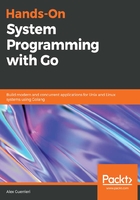
Summary
In this chapter, we saw what system programming means—writing system software that has some strict requirements, such as being tied to the hardware, using a low-level language, and working in a resource-constrained environment. Its practices can be really useful when building distributed systems that normally require optimizing resource usage. We discussed APIs, definitions that allows software to be used by other software, and listed the different types—the ones in the operating system, libraries and frameworks, and remote and web APIs.
We analyzed how, in operating systems, the access to resources is arranged in hierarchical levels called protection rings that prevent uncontrolled usage in order to improve security and avoid failures from the applications. The Linux model simplifies this hierarchy to just two levels called user and kernel space. All the applications are running in the user space, and in order to access the machine's resources they need the kernel to intercede.
Then we saw one specific type of API called system calls that allows the applications to request resources to the kernel, and mediates process control, access and management of files, and devices and network communications.
We gave an overview of the POSIX standard, which defines Unix system interoperability. Among the features defined, there are also the C API, CLI utilities, shell language, environment variables, program exit status, regular expressions, directory structures, filenames, and command-line utility API conventions.
In the next chapter, we will explore the Unix operating system resources such as the filesystem and the Unix permission model. We will look at what processes are, how they communicate with each other, and how they handle errors.